Listen, if you’re tired of tripping over garden tools, bikes, or your kids’ toys in the backyard, it’s time to get serious about storage. I’ve been there—chaos everywhere, no space to breathe.
That’s why I’m telling you to snag a Patiowell plastic shed. It’s a game-changer: spacious, sturdy, and easy to set up. Trust me, after wrestling with cluttered patios and leaky metal sheds, this is the upgrade you didn’t know you needed.
Stick with me—I’ll walk you through my journey, the good stuff, the not-so-great bits, and why it’s worth every penny.
My Experience With The Patiowell Plastic Shed
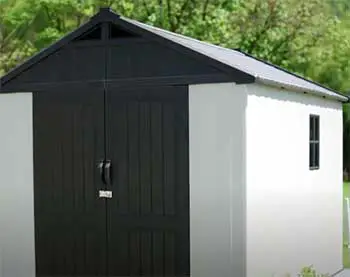
So, picture this: my backyard was a mess.
Lawn tools scattered, my bike leaning precariously against the house, and a pile of outdoor toys that seemed to multiply overnight. I’d had enough.
I ordered the Patiowell 8×6 plastic shed, and when those four boxes showed up (yes, four—patience is key here), I was equal parts excited and nervous.
Could I really tackle this solo? Spoiler: I did, and it was a wild ride.
The assembly took me about six hours—longer than the advertised 2-3, but I’m no pro. The “kick-it” method? Genius. You just press the panels down and give ‘em a good kick to lock them into the base. It felt oddly satisfying, like I was building something primal.
I’ll admit, though, when it came to the roof trusses, I wished I’d roped in a buddy. Those floppy walls had me cursing as I balanced the metal bars alone. Pro tip: get a helper for that part, or you’ll be me—sweating and muttering at 3 p.m.
Once it was up, I was impressed. The beige walls and gray roof looked sleek, and that window? It’s a vibe—natural light pouring in, no flashlight needed. I tossed in my mower, tools, and even some patio cushions.
The plastic floor felt solid underfoot, and I could tell this thing was built to last. Then came the real test: a storm rolled through with 60 mph winds and pounding rain. I braced myself for disaster, but the shed didn’t budge—no leaks, no wobbles.
I added some mesh over the vents to keep wasps out (learned that trick the hard way), and now it’s my little backyard fortress. Honestly, it’s been a relief to reclaim my space.
Pros of The Patiowell Plastic Shed
Okay, let’s talk about why I’m hooked on this shed. It’s not just a box—it’s a solution, and it’s got some serious perks.
- Spacious Enough to Fit Your Life
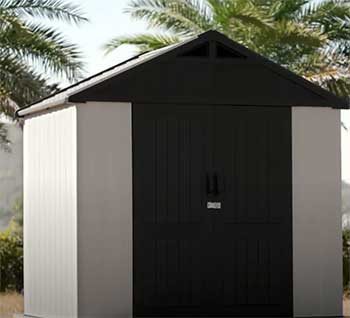
First off, the size is a dream.
At 66.1 inches deep, 91.3 inches wide, and 94.5 inches tall, this thing swallows up everything I throw at it.
My lawnmower? In.
My gardening gear?
Yup. Even my bike and some random sports stuff fit with room to spare. It’s like Mary Poppins’ bag—deceptively huge inside.
You won’t be playing storage Tetris here; it’s got space for your chaos and then some.
- Tough as Nails (But Lighter)
The durability blew me away. Made from recyclable, UV-resistant plastic, it laughs at rain, wind, and sun. I’ve seen metal sheds rust and wooden ones rot, but this? It’s still standing pretty after a brutal winter.
The hurricane I mentioned? No cracks, no leaks—just a shrug and a “bring it on.” Plus, it’s lightweight enough that I didn’t herniate myself hauling the pieces around during setup.
- That Plastic Floor is a Game-Changer
The included plastic floor base? Absolute gold. It’s sturdy, keeps everything off the damp ground, and adds an extra layer of stability. I don’t worry about moisture creeping in or my tools getting soggy.
Compared to metal sheds I’ve owned where the floor was an afterthought, this feels intentional—like Patiowell actually cares about keeping my stuff safe.
- Easy Assembly (Mostly)
I can’t rave enough about the “kick-it” setup. Cutting screws by 35% means less fiddling with tiny hardware and more actual building. The instructions are all pictures, which threw me at first, but once I got the rhythm, it was smooth sailing—well, except for those trusses.
If you’ve ever wrestled with a metal shed’s 500 screws, you’ll appreciate this. It’s not instant, but it’s way less of a headache.
- Looks Good, Feels Practical
Let’s be real—it’s pretty. The beige-and-gray combo blends into my yard without screaming “storage unit.” That adjustable window?
It’s not just for show; it lets in light and lets me peek inside without unlocking the door. It’s functional and stylish, which isn’t something I’d say about most sheds.
- Weather Warrior
This shed’s weather resistance is no joke. From 60 mph winds to heavy rain, it’s held strong. I’ve even noticed it expands and contracts with temperature swings without falling apart—something my old metal sheds couldn’t handle.
It’s like it’s built for the real world, not just a sales pitch.
Cons of The Patiowell Plastic Shed
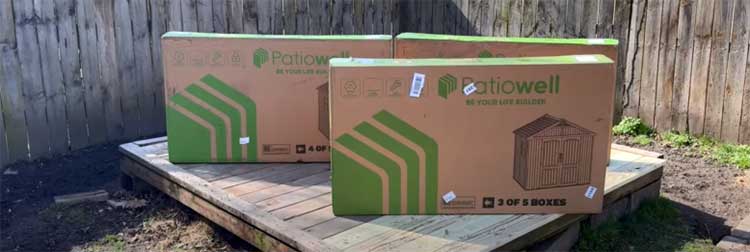
Now, I’m not here to sugarcoat it. There are some downsides you’ll want to know about before you commit.
- Door Security Could Be Better
The door’s a weak spot. It’s plastic, like the rest of the shed, and while it locks, it’s not Fort Knox. I wouldn’t trust it with high-value items—a determined thief could probably pry it open.
It’s fine for tools and toys, but if you’re storing heirlooms or pricey gear, you might need a backup plan.
- Walls Aren’t Built for Hanging
Don’t expect to turn this into a workshop with pegboards. The walls are flexible—great for durability, not so much for mounting shelves or heavy tools.
I tried hanging a rake, and it just didn’t feel secure. If you’re a DIYer who loves wall storage, this might cramp your style.
- Assembly’s a Solo Struggle at Times
I built it alone, but I wouldn’t recommend it. The roof trusses and gables? They’re a two- or three-person job unless you’ve got octopus arms.
The walls flop around until everything’s locked in, which made me wish I’d called a friend. It’s doable solo, but it’ll test your patience.
- Delivery Can Be a Puzzle
Four boxes, multiple deliveries—it’s a logistical dance. Mine arrived over a week, and I panicked when Amazon marked it “delivered” after just one box. Patiowell’s customer service sorted it out with tracking numbers, but it’s a hassle you’ll need to brace for.
Check those packages like a hawk.
- Temperature Tantrums
The shed handles weather like a champ, but extreme cold? It shrank enough once that the door latch stuck for days. It’s not a dealbreaker, but if you live where temps swing wildly, you might face a few quirks.
It’s a small price for the overall toughness, though.
Maintenance Tips For Your Patiowell Plastic Shed
Keeping this shed in tip-top shape isn’t rocket science, but a little care goes a long way. Here’s what I’ve learned to keep mine humming.
- Clean It, Don’t Ignore It: Dust and dirt love to cling to plastic. I grab a hose and a mild soap solution—like dish soap and water—every few months. A quick scrub with a soft brush keeps it looking fresh. Don’t blast it with a pressure washer, though; you might dent those flexible walls.
- Check the Roof and Vents: After storms, I peek at the roof. The sloped design sheds water well, but leaves or debris can pile up. A broom clears it fast. Those vents? Make sure your mesh (if you added it) isn’t clogged—airflow’s key to avoiding moldy surprises inside.
- Anchor It Right: I learned this the hard way: a solid base matters. I set mine on a level concrete slab and anchored it with screws. If you’re on dirt or gravel, double-check it’s stable—wind can be sneaky. A wobbly shed’s a sad shed.
- Watch the Door in Extreme Weather: That temp-shrinkage thing? Keep an eye on the door during cold snaps. I wiggle the latch gently if it sticks—no forcing it, or you’ll snap something. A little silicone spray on the hinges helps it glide, too.
- Inspect for Wear: Plastic’s tough, but not invincible. I walk around mine every season, checking for cracks or warping. So far, so good, but catching small issues early saves you big headaches. If something’s off, Patiowell’s customer service is clutch—they’ve got your back.
Comparison of Patiowell Plastic Shed With Other Brands
So, how does the Patiowell plastic shed hold its own against the big players? I’ve had my hands on a few sheds over the years, and I’m breaking it down for you—Patiowell vs. Keter, Arrow, and Suncast.
Let’s see who comes out swinging.
- Patiowell Vs. Keter Plastic Sheds
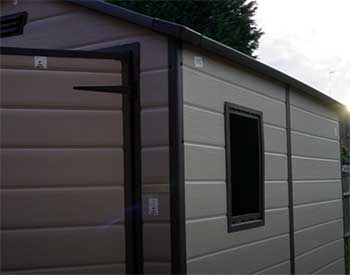
You’ve probably seen Keter sheds everywhere—they’re the sleek, modern kings of plastic storage.
I’ve used their Artisan line, and it’s a fair fight against Patiowell.
Size-wise, Patiowell’s 8×6 (66.1″D x 91.3″W x 94.5″H) gives you more elbow room than Keter’s typical 7×7 options—great if you’ve got a mower or bikes to stash.
Keter’s got a fancier look, though, with wood-like textures that might win over your HOA.
Patiowell’s beige-and-gray combo is sharp but simpler.
Assembly? Patiowell’s “kick-it” method cuts screws by 35%—I had it up in six hours solo. Keter’s snap-together system is slick too, but I spent closer to eight hours wrestling with their tiny clips. Durability’s a toss-up—both use tough, UV-resistant plastic.
My Patiowell survived 60 mph winds, and Keter’s held up in storms too, but Patiowell’s metal-reinforced roof feels like an edge. Security’s weak on both—plastic doors aren’t stopping anyone determined. Price?
Keter’s often pricier per square foot, so Patiowell wins on value. You pick Keter for style, Patiowell for space and ease.
- Patiowell Vs. Arrow Sheds
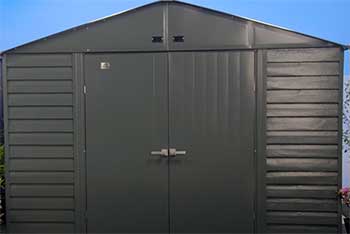
Arrow’s metal sheds are the budget warriors—I’ve owned three, and they’re a whole different beast from Patiowell.
Cost?
Arrow wins hands-down; you’ll pay a quarter of Patiowell’s price. But you get what you pay for.
My Arrow sheds were tiny—short walls, low doors—and I’ve got the forehead bruises from ducking in.
Patiowell’s 94.5-inch height? No stooping required. Space-wise, Patiowell’s 8×6 crushes Arrow’s standard 6×4 or 8×3 layouts—more room for your gear, less Tetris.
Setup’s where Arrow flops. Hundreds of screws, vague instructions—I’d spend a full day swearing at it. Patiowell’s six-hour “kick-it” build was a breeze by comparison. Durability?
Patiowell’s plastic laughed off rain and wind; my Arrow sheds rusted in five years and leaked like sieves. Maintenance is Arrow’s downfall too—repainting metal beats hosing down Patiowell’s plastic any day.
Security’s tighter with Arrow’s steel, but who cares when the walls dent? You’re trading cheapness for headaches—Patiowell’s worth the extra cash.
- Patiowell Vs. Suncast Sheds
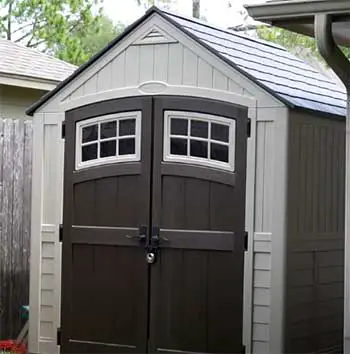
Suncast is Patiowell’s closest plastic cousin—I had their Cascade model once, so I’ve got a front-row seat for this showdown.
Size is a split decision. Patiowell’s 8×6 fits more than Suncast’s typical 7×4, but Suncast offers bigger options like 10×10 if you splurge.
I loved Patiowell’s height (94.5 inches) over Suncast’s shorter ceilings—no crouching needed.
Looks?
Suncast’s taupe-and-brown palette edges out Patiowell’s beige-gray for warmth, but that adjustable window on Patiowell adds practical flair.
Assembly’s where Patiowell pulls ahead. Suncast’s clip-heavy setup took me seven hours, and the instructions were a mess—half the pieces didn’t match the pics. Patiowell’s “kick-it” vibe? Six hours, less swearing.
Durability’s a biggie—my Suncast shed cracked in high winds, while Patiowell’s metal roof reinforcement tanked a 60 mph storm. Both have flimsy plastic doors, so no winners there. Price-wise, Suncast’s mid-range cost is close to Patiowell, but you’re paying for less resilience.
Suncast’s fine, but Patiowell’s tougher and easier—your call.
Frequently Asked Questions (FAQ)
Look, plastic sheds like Patiowell’s aren’t perfect. The big drawback? Those flexible walls and so-so door security. You can’t hang heavy stuff or trust it with super-valuable items—a metal or wooden shed might edge it out there. Plus, extreme temp swings can make it contract or expand, which might mess with the latch.
Tough call, but Patiowell’s up there. I’ve tried Suncast and Rubbermaid too—Suncast’s solid but flimsier in wind, and Rubbermaid’s great but small. Patiowell’s mix of size, durability, and that “kick-it” ease gives it a leg up for me. They’re not flawless, but they nail the practical stuff.
Absolutely, if they fit your needs! Mine’s been a champ—weatherproof, low-maintenance, and roomy. They’re not as rigid as metal or wood, so skip ‘em for heavy-duty storage or high-security spots. But for tools, toys, and garden gear? You’ll love ‘em.
With care, I’d bet on 10-15 years, maybe more. Patiowell’s UV-resistant plastic and sturdy build suggest it’ll outlast my old metal sheds, which rusted out in five. Keep it clean, anchored, and out of brutal conditions, and it’ll stick around.
Conclusion: Your Backyard Deserves a Patiowell Plastic Shed
Here’s the deal: if you’re drowning in outdoor clutter, the Patiowell plastic shed is your lifeline. I’ve lived it—six hours of kicking panels, a storm-tested survivor, and a yard I can finally enjoy. It’s not perfect—flimsy walls and a meh door—but the space, durability, and easy upkeep?
Worth it. Grab one, kick it together, and watch your chaos vanish. You’ll thank me later.

07/31/2025
I’m awaiting a response from Patiowell concerning the Warranty. Lifetime ? But on What?
You say 10 to 15 years, if Lifetime Warranty I shouldn’t have to worry about anything..
Its $250 more then Home Depot (1 yr manufacture Warranty only) and that’s the only concern is the Warranty
What year is your review from?